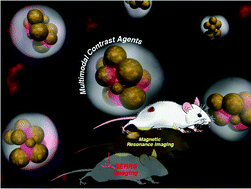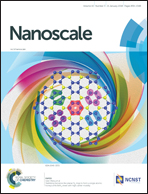A SERRS/MRI multimodal contrast agent based on naked Au nanoparticles functionalized with a Gd(iii) loaded PEG polymer for tumor imaging and localized hyperthermia†
Abstract
Multimodal contrast agents offer new interesting diagnostic possibilities, summing the benefits of multiple imaging techniques. Magnetic resonance and optical imaging are complementary techniques. The first allows total body screening, even though it suffers from low spatial resolution and needs high loadings, whereas the second shows lower penetration, but bright signals, and a higher spatial resolution and needs lower loadings. We present a plasmonic nanosystem as a MRI (magnetic resonance imaging) and SERRS (surface enhanced resonance Raman scattering) multimodal contrast agent. Naked gold nanoparticles, obtained by laser ablation synthesis in solution, are organized as a highly efficient SERRS substrate with a naphthalocyanine reporter and functionalized with a MRI contrast agent with a newly synthesized 3DOTA-PEG polymer, with a high GdIII loading. As a proof of concept, in vivo and ex vivo MRI and SERRS experiments are also performed. The plasmonic property of the nanosystem is then exploited to show its usefulness for localized hyperthermia.



 Please wait while we load your content...
Please wait while we load your content...